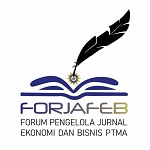Online Submissions
Already have a Username/Password for Value Added : Majalah Ekonomi dan Bisnis?
Go to Login
Need a Username/Password?
Go to Registration
Registration and login are required to submit items online and to check the status of current submissions.
Author Guidelines
Carefully read the submission guidelines as follows:
A. General Requirements
The minimum standard requirements of Value Added : Majalah Ekonomi dan Bisnis (VAMEB) must be:
- Manuscripts written in English or Bahasa with Arial font;
- Writing at least 8 pages long and no more than 15 pages (exclude references);
- Use Mendeley Software for reference management with American Psychological Association (APA) as a list of references style;
- The paper begins with the manuscript title, author name, author affiliation, address followed by an abstract;
- Manuscript with the Online Submission System (OSS) at https://jurnal.unimus.ac.id/index.php/vadded;
- Make sure that your paper is prepared by referring the Value Added : Majalah Ekonomi dan Bisnis paper template (link);
- Notification of acceptance: within 30 (thirty) days after the date of the manuscript is sent.
B. Structure of the Manuscript
- Abstract – is written in one paragraph explaining in brief about research objective, problems (by mentioning researched variables), research methodology, samples and sampling method, results/findings. Abstract should be written by using Arial font 11pt, one space, and Justify. Maximum 200 words in one paragraph, no formulas, no pictures, no subsections, no references, and no statistics.
- Keywords – should be written in English and Indonesia, Time New Roman 11pt, one space, and Justify. 3 to 5 words or phrases. Be separated by commas and not to exceed 3 lines.
- Introduction – should contain (structured) general background, the problem, previous literature review (state of art) as the basis of a statement of the scientific novelty of the article, a statement of scientific novelty, and the research problem or hypothesis. At the end of the introduction should be written the purpose of the article studies. In a scientific article, the format is not allowed for the review of the literature as well as in a research report, but expressed in the previous literature review (state of the art) to demonstrate the scientific novelty of the article and can be written development conceptually based on previous research studies.
- Theoritical Review (and Hypothesis Development – for quantitave approach) – should outline grand theory as the fundamental theory covering the research, and next by outlining the theory of each variable applied. This theoretical review will comprise the relationship among variables, relevant research, research framework, and research hypothesis built. All citations in Theoretical Review must have reference source (name, year), except conclusion made by the author. All citated references have to be listed in Bibliography. Citated references minimum 50 percent from journals. Those journal were published maximum seven years old. The headings should not written using numbers. Each headings should not exceed 12 words. The distance between the heading and text is one space. The body text should be written in one space. The sub-headings should not written using numbers. The sub-headings should not exceed 12 words.
- Methods – outlines briefly about the research subject and object, variable operationalization, population and samples, the sampling method, and the statistical test applied in the research. This section should be structured, clear, and understandable as well as the right to use the method.
- Results – shows the findings of scientific research in accordance with the method used. but must be supported by data and facts sufficient. No discussion on the results of research findings, this section describes only the findings of the research results.
- Discussion – is not re-write the research findings, but more scientifically reviewing the results of research, not restate data obtained research results. The scientific findings should be described in Science include: Do the scientific findings obtained? Why did it happen? Why such a variable trend? All these questions must be explained scientifically, not merely descriptive, must be supported by scientific phenomena. Furthermore, it should be explained also in comparison with the results of other researchers about the same topic. The results of the research and findings must be able to answer the research hypotheses in the introduction.
- Conclusions – summarizes the answers of the hypothesis or research purposes or scientific findings obtained. Conclusions do not contain repetition of results and discussion, but rather to a summary of the findings as expected on purpose or hypothesis. If necessary, at the end of the conclusion can also write recommendations for the next research.
- References – contains All citations that must be listed in this section and all sources in this section must be cited. This means that the amount of citations has to be exactly the same with the amount of references (not more or less). The article must contain at least 15 sources of references, and please ensure that the main journal is listed in the citation as well as in the bibliography/reference. Bibliography is arranged in the authors’ alphabetical order, without differentiation among books, journals, and online journals. The references referred to in body text should be written in the bibliography using Mendeley Software in American Psychological Association (APA) style. No pictures or formulas in reference. The references should be used at least the last 7 years. The references should be sourced at least 50% from the journal. The references should be searchable online.
Submission Preparation Checklist
As part of the submission process, authors are required to check off their submission's compliance with all of the following items, and submissions may be returned to authors that do not adhere to these guidelines.
- The submission has not been previously published, nor is it before another journal for consideration (or an explanation has been provided in Comments to the Editor).
- The submission file is in OpenOffice, Microsoft Word, RTF, or WordPerfect document file format.
- Where available, URLs for the references have been provided.
- The text is single-spaced; uses a 12-point font; employs italics, rather than underlining (except with URL addresses); and all illustrations, figures, and tables are placed within the text at the appropriate points, rather than at the end.
- The text adheres to the stylistic and bibliographic requirements outlined in the Author Guidelines, which is found in About the Journal.
- If submitting to a peer-reviewed section of the journal, the instructions in Ensuring a Blind Review have been followed.
Copyright Notice
Authors who publish with Value Added : Majalah Ekonomi dan Bisnis (VAMEB) agree to the following terms:
Authors retain copyright and grant the journal right of first publication with the work simultaneously licensed under a Creative Commons Attribution License that allows others to share the work with an acknowledgement of the work's authorship and initial publication in this journal.
Authors are able to enter into separate, additional contractual arrangements for the non-exclusive distribution of the journal's published version of the work (e.g., post it to an institutional repository or publish it in a book), with an acknowledgement of its initial publication in this journal.
Authors are permitted and encouraged to post their work online (e.g., in institutional repositories or on their website) prior to and during the submission process, as it can lead to productive exchanges, as well as earlier and greater citation of published work (See The Effect of Open Access).
Privacy Statement
The names and email addresses entered in this journal site will be used exclusively for the stated purposes of this journal and will not be made available for any other purpose or to any other party.










